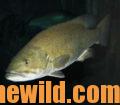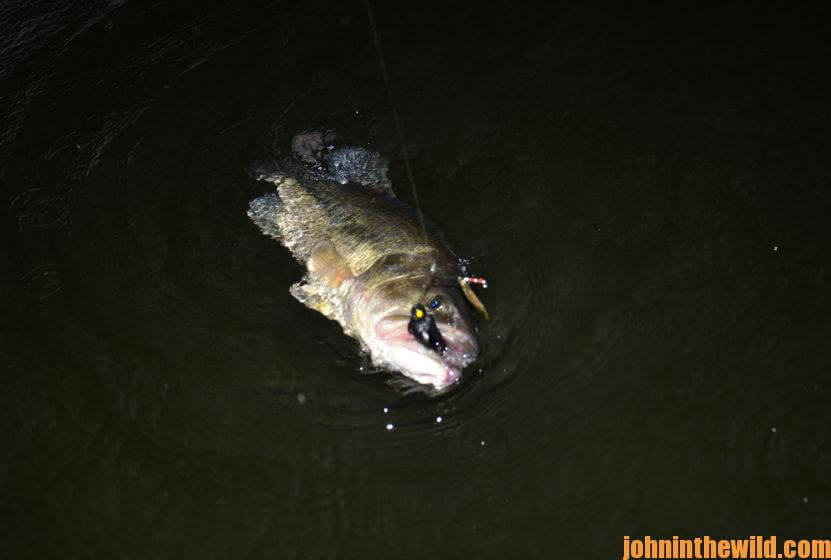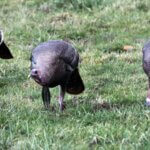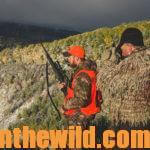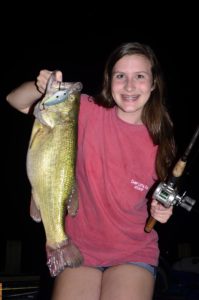 Editor’s Note: Even a dog knows to get out of the sun when the temperature is 90+ degrees, and many bass anglers across the nation have discovered that bassing is more productive after dark on most rivers and lakes in the summertime. Phillip Criss of Albertville, Alabama, guides bass fishermen on Lake Guntersville, 150 to 175 days every year and fishes about 100 more days when he’s not guiding. Guntersville is ranked the No. 2 big-bass lake in the U.S. Criss often fishes at night for bass and says that the best night fishing for bass on Guntersville usually starts during the month of May and continues until the end of September.
Editor’s Note: Even a dog knows to get out of the sun when the temperature is 90+ degrees, and many bass anglers across the nation have discovered that bassing is more productive after dark on most rivers and lakes in the summertime. Phillip Criss of Albertville, Alabama, guides bass fishermen on Lake Guntersville, 150 to 175 days every year and fishes about 100 more days when he’s not guiding. Guntersville is ranked the No. 2 big-bass lake in the U.S. Criss often fishes at night for bass and says that the best night fishing for bass on Guntersville usually starts during the month of May and continues until the end of September.
When and Where to Fish the Jig for Bass on Hot Nights:
“The jig seems to pay the most dividends this month when fished on riprap or around bridges,” Criss explains. “But I prefer to fish the jig on old, underwater road beds, especially where there’s a culvert that goes under the roadbed. Also you’ll find some old roadbeds at underwater barge-loading facilities. Although those roadbeds were built 50-100 years ago, the culverts are still there. Another great place to catch a bass at night is around old underwater house foundations. If you know where these types of underwater structures are, you can do well fishing a jig around them. I’m often asked, ‘Do you use a football-head jig or a round-head jig when you fish at night?’ The answer is I fish both, depending on the type of structure. If I’m fishing around rocks, I’ll use a football-head jig. If I’m fishing a rough-gravel type bottom, I’ll use a round-head jig. I usually fish the football-head jig the most. Another reason I like to fish roadbeds, culverts, foundations of underwater houses and barge-loading facilities is most of the night fishermen on Guntersville and other lakes will be fishing the riprap that’s around the bridges and causeways with numbers of street lights. Then anglers can see the structure better and how to tie on or change lures than in the pitch-black dark where I like to fish.
“I’m also asked, ‘Are you bouncing off the structure you plan to fish at night?’ No, I’m not. I have a Humminbird (http://www.humminbird.com/) side-scanning depth finder that has a feature called the casting ring. When I mark the structure I want to fish as a waypoint, I turn on my casting-ring feature that I can move out to a distance from where I want to be able to cast. If you can cast 60 feet, you set the casting ring up for 60 feet. Then the Humminbird depth finder will draw a 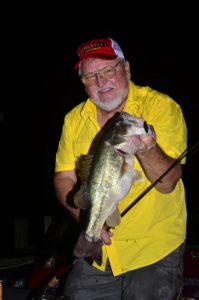 casting ring 60-feet from your waypoint. The advantage of using the casting ring is that I can watch my depth finder, keep my boat on that casting ring and fish all the way around that structure. Also, I can see where my boat is positioned along that casting ring and keep the boat away from the structure I want to fish. I believe that using the casting ring is a great advantage, especially for night bass fishermen.
casting ring 60-feet from your waypoint. The advantage of using the casting ring is that I can watch my depth finder, keep my boat on that casting ring and fish all the way around that structure. Also, I can see where my boat is positioned along that casting ring and keep the boat away from the structure I want to fish. I believe that using the casting ring is a great advantage, especially for night bass fishermen.
“Another helpful hint that will make you more effective for bass by using a casting ring is to go out in your backyard, put a jig or a worm on your rod, and make a cast that’s comfortable for you. Lay your rod down right where you’re standing. Then measure the length of line from the tip of the rod to where your jig or worm is with a yard stick or a tape measure. That way, you know the distance you need to use to set-up your casting ring that allows you to fish most comfortably and make more-precise casts to your target. Even when I’m fishing on a completely-moonless night, by watching my depth finder, I’ll know where the structure is on the bottom. Keeping my boat moving around the casting ring, I consistently can make casts all the way around that structure without being able to see anything.”
Why Fish Community Holes at Night for Hot Weather Bass:
On every lake, certain areas are marked on maps and known by local fishermen as community holes – specific spots where anglers consistently have caught big bass and/or numbers of bass. Since these sites are fished heavily in the daytime, the bass holding there are sensitive to angler pressure. However, generally when a location is marked as a community hole, some type of underwater structure or current flow is present, causing bass to hold in that location. At night, especially from about 10:00 pm until 3:00 am, Criss fishes those community holes. No one else is fishing for them then, and bass will load-up on these locations late in the night or early in the morning.”
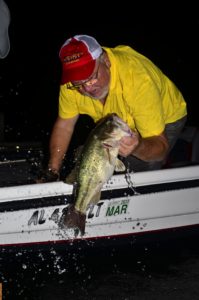 Why Farm for Bass:
Why Farm for Bass:
For many years, crappie and bass fishermen have put-out brush shelters to attract fish. “In 2015, I went on a mission to make sure I had places where I could take my clients to catch bass,” Criss reports. “I sunk 400-Christmas trees in different places all over the lake, and I logged the GPS readings of them into my depth finder. When I’m checking my Christmas trees to see if they’re holding any bass, I stay well away from them with my boat and use my side-scanning depth finder. If bass are holding on them, especially at night, I use my casting-ring feature on my depth finder to stay a casting distance away from those Christmas trees and cast to them. I’ll mainly fish a spinner bait and a Texas-rigged 11-inch worm to fish Christmas trees. I don’t cast the spinner bait, so that it sinks into the tree. I’ll fish the spinner bait over the tops or around the sides of the trees to draw the fish out of the trees to take the spinner bait.
“I can cast this worm closer to the tree or let it fall down into the tree to catch the bass, since Texas-rigged plastic worms can be pulled out of trees without spooking bass much easier than jigs or spinner baits can. When I’m fishing that big worm, and I feel a bite, I take up slack as quickly as I can and set the hook. Most of my Christmas trees are sunk from 10-20 feet deep, but you can catch Guntersville bass deeper than 20 feet at certain times of the year. Drop shotting, fishing swimbaits, or fishing the Alabama rig (http://www.thealabamarig.com/) will produce bass that are deeper than 20 feet on Guntersville. However, at night, I don’t fish any of those deep-running baits. I rarely ever fish water 20 foot deep or deeper – night or day.”
What Equipment Criss Uses:
“I fish with Bass Pro Shops (http://www.basspro.com/), Boyd Duckett (http://duckettfishing.com/home.php) and some All Star rods (http://www.allstarrods.com/),” Criss explains. “I like a medium to medium-heavy 7’ to 7-1/2’ rod and a baitcasting reel. I primarily fish all big lures in the summer, because the crawfish will be 4-5 inches long, and the shad will be much bigger than they’ve been in the spring. We catch big bass here at Guntersville at night, and I believe big bass eat big baits. The largest bass I’ve ever caught at night at Guntersville weighed 9 pounds, but I have friends who have caught bass up to 10-11 pounds fishing at night. If I only can give one suggestion to help a person catch a big bass fishing at night at Guntersville or other lakes – buy several lake maps, and look for underwater structure away from the marinas and riprap. If possible, fish with a buddy who has a side-scanning depth finder, or use your depth finder to locate structure where other night fishermen aren’t fishing – usually somewhere in the middle of the lake.”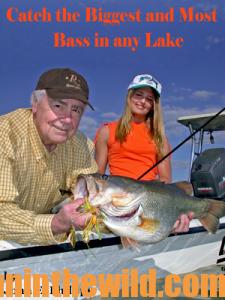
To contact Phillip Criss, call 205-461-5549.
To learn more about bass fishing, check out John E. Phillip’s book, “Catch the Biggest and the Most Bass in Any Lake,” at http://amzn.to/Xd7qez and available in Kindle, print and Audible versions.


